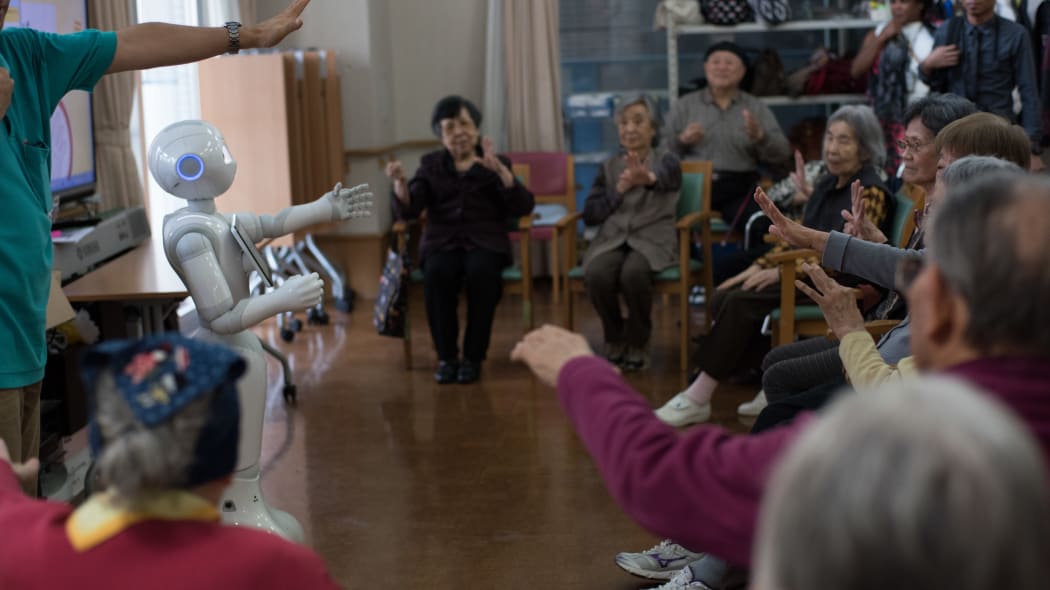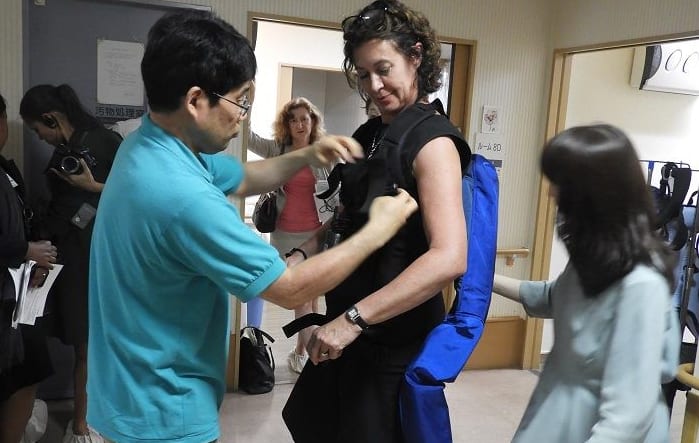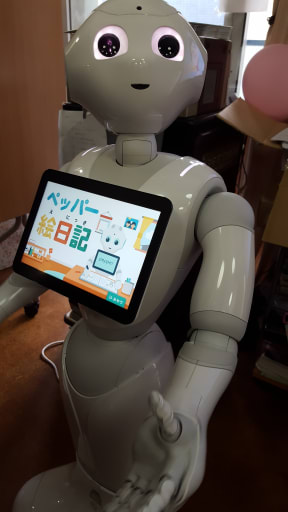A high pitched, child-like voice floats up the corridor as you step out of the lift at Shintomi Rest Home in Tokyo.
It is recreation time and the residents are singing along to an action song led by Pepper the robot.

Pepper the robot in full flow. Photo: RNZ / Philippa Tolley
The elderly men and women are lined up in chairs and wheelchairs in a room with sensible lino floors, much as they are in every nursing home I’ve ever visited. But here, not only is Pepper out the front, other small robots are part of the afternoon action as well and all the elderly seem to be tapping their feet and swaying along with the tune.
One man shoos me out of the way when I accidentally block his view of Pepper and he gets out of step with the songs and the actions. Another gentleman, who tells me he is too old to remember his age, says it is fun and adds a bit of variety to have the child-size robot leading the daily music and exercise sessions. He found it a bit odd to begin with, but her encouragement to get involved and sing along are now just part of daily life. Along with his fellow retirees, he claps and chortles as Pepper and a smaller, desk-top-sized robot, spar over who is singing the best.
In another room a responsive soft toy, modelled on a baby harp seal, responds to the caress of a dementia patient. The soft, fluffy seal pup flutters its long eye lashes, gently murmurs and turns its head.
At another table, small robot dogs move and respond to pats and words. The robots look like toys, but are designed to sooth and interact with the patients, who are fully engaged with their own plastic version of a “fur baby.” They seem happy and quietly chat with their pets. For the staff, that means not being tied up with distressed patients.
Some of the rehab equipment at this nursing home is also classified as a robot. If the machine can be programmed, it’s a robot even if its appearance bears no relation to anything living. Some of these rehab robots help with exercise and others help the staff themselves.
I tried on a sort of exo-skeleton worn on your back like a cross between a pack and a very lumpy jacket. Compressed air stiffened the structure that reinforced and supported nurses who were bending over to lift, or care for patents in bed.
But this isn’t all about a fun way to pass the afternoon or just help staff in their day-to-day tasks. This is a serious experiment to discover whether robots can take over some of the duties in the rest home, or at least help the nurses look after more people in the face of staff shortages.

The exo vest helps carers lift and bend more safely. Photo: RNZ
There is no sense that robots could take on the role of a nurse. But many of the devices in the Shintomi rest home were helping to make work more efficient and to monitor the safety of the patients more carefully.
And the need for such care in Japan is only going to escalate. The pressing issue for this nation is the aging population and its frequent partner; the declining workforce. New Zealand also faces increasing numbers of older people and fewer younger people working. But Japan is experiencing what has been described as a “super aging” society. In 2014, 33 percent of the Japanese population was older than 60.
Japan’s prime minister, Shinzo Abe, has responded with policies which aim to keep people working until they are older and to get women more involved in the work place. The latter has been dubbed “womenonmics.” But at the same time Japanese work traditions conditions continue. Many stay at the office for very long hours. A fellow journalist I meet in Tokyo is at work at 8am and doesn’t get home until 11pm.
It seems unsurprising under these conditions that so many are opting not to have a family or to have only one child. Anecdotally, people talk about being able to spend little time with their children. A student teacher explained that during a work placement, a number of primary school children in her care were so stressed they chose to spend their days in the sick room, rather than deal with the social atmosphere and demands of the classroom.

Photo: RNZ / Philippa Tolley
These demographic tensions may well be having an impact on everyday life in Japan. In the United Nations World Happiness Rating for this year, Japan was placed at 53 out of 156 (New Zealand came in at 8). Not exactly the worst, but for a nation with so many positives, such as longevity of its people, one might have predicted a better outcome.
But for the robots it’s a happy story. With increasing numbers of elderly and fewer people to look after them, the future for Pepper, and her new versions to come, looks like being rosy.
Philippa Tolley is RNZ Insight’s presenter and executive producer. She received the Jefferson Fellowship award for 2017 and is travelling with a group of other journalists around the Asia Pacific region. Her trip was made possible by a grant from the Asia New Zealand Foundation.


